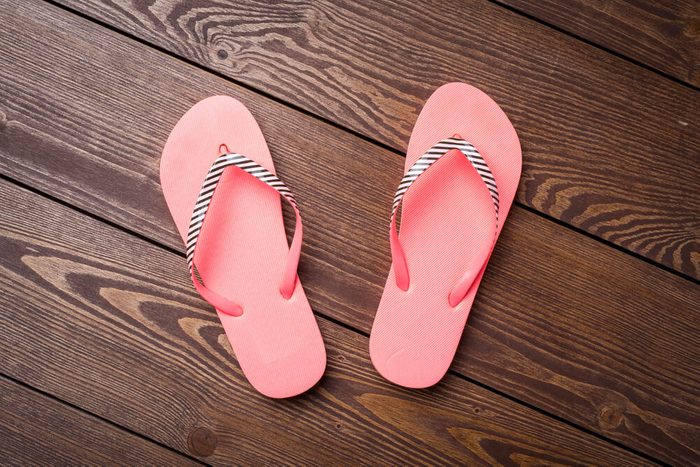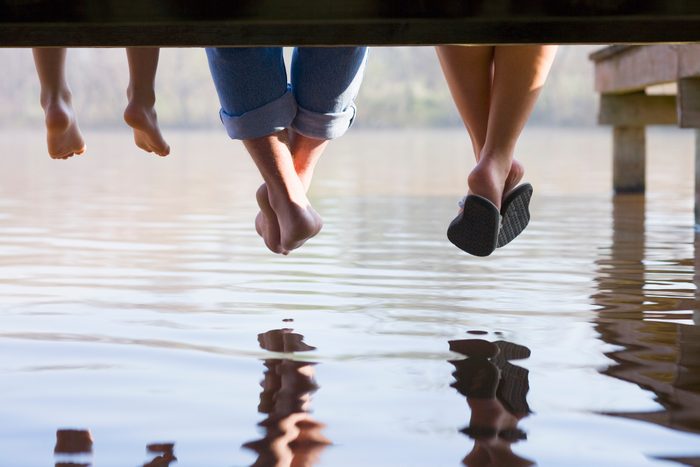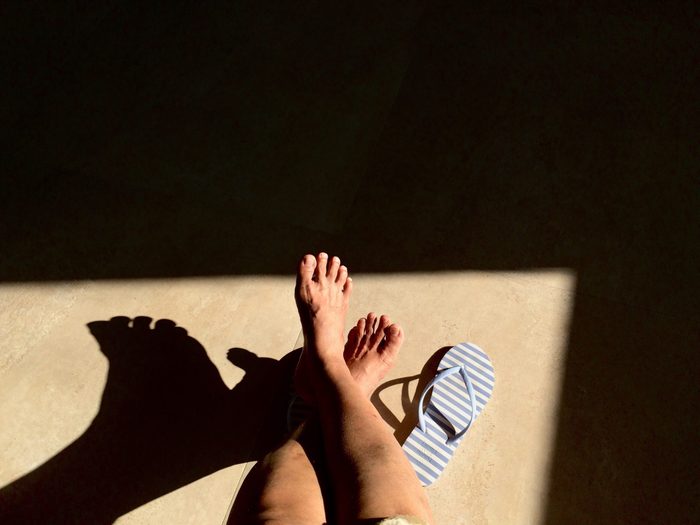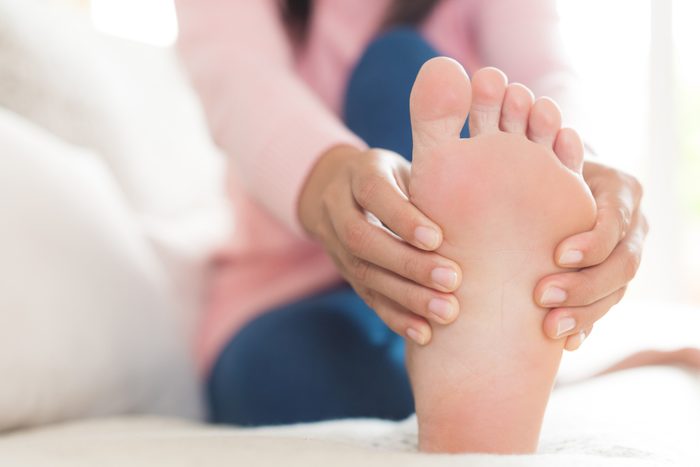
Is it bad to wear flip-flops?
There’s no feeling like slipping into a pair of flip-flops to let your feet breathe after a long day of wearing sneakers or dress shoes. And, if you’ve spending more time at home due to Covid-19, you may be wearing them right now. (Or perhaps you’re sporting a pair of these comfy podiatrist-recommended slippers.) You may hold on to your favorite pair of flip-flops due to the comfort and convenience (no shoe tying required), but you should probably think twice before you make them your daily footwear. (Also, this is why you should avoid walking around barefoot.)
Flip-flops may be the preferred footwear for the summer, but one podiatrist highlights the potential dangers of wearing them every day, from blisters to plantar fasciitis, and more.

You could sprain your ankle
Those rubber flip-flops you picked up for cheap are fine for the beach, but you won’t want to wear them all day. They have virtually no arch support, which means your feet will start to turn toward the middle of your body instead of staying straight. When that happens, you’re more likely to sprain your ankle, says Eunice Ramsey-Parker, DPM, MPH, associate professor of podiatric medicine and clinic administrator of the Foot Center of New York. “They won’t trip over anything, but because they don’t have support, they twist their ankle in or out,” she says. (Finally learn the difference between a sprain, strain, and fracture.)

You foot could get inflamed
Even if you’re extra careful and don’t twist your foot, that lack of arch support could hurt your feet. Without the right support, your plantar, the band of tissue in the arch of your foot, will start to pull. That pulling inflames the tissue, making your arch red and painful from a condition called plantar fasciitis. “When you try to step down on your foot, you have excruciating pain in the arch,” says Dr. Ramsey-Parker. To get the inflammation down, you might need to use anti-inflammatory medications like ibuprofen, physical therapy, exercise, or cortisone injections. (Swap your flip flops for a pair from our list of best shoes for plantar fasciitis.)

Foot problems could run bone-deep
With too many bouts of plantar fasciitis, your body will start producing new bone to try to heal the pulling. With more bone than the body needs, a buildup called a heel spur could develop on the back or bottom of your heel. “The spur is like a little point that’s pinching and pulling,” says Dr. Ramsey-Parker. “It’s a very painful area.” If the same treatments used for plantar fasciitis don’t work, you might need surgery to get it back to normal, she says. (These are the best shoes for heel spurs to get relief.)

Objects could poke through your foot
It doesn’t take long for a pair of cheap flip-flops to get worn down to practically nothing. Once the heel and toe start to depress, it’s easy for nails, glass, and other dangerous objects on the ground to poke through. But the flip-flops themselves create a bigger problem that a tetanus shot won’t protect against. “Part of the shoe [can] actually become embedded in their foot and create a foreign body,” says Dr. Ramsey-Parker. “The body heals very quickly and they’re still having pain. On an X-ray we can see the shadow of a small piece of rubber in the foot.” At that point, surgery is your only option. (Check out these foot doctors’ tips for wearing sandals safely.)

You’ll twist your toes in—and they’ll stay there
Flip-flops are, well, floppy, so you probably need to curl your toes down to keep them from flying off while you walk. But wear them enough and they might not straighten out once your shoes are off. “The toes actually bend up and stay in a fixed position that looks like a little hammer,” says Dr. Ramsey-Parker. It’s a deformity called—you guessed it—hammertoe. Here are more foot care secrets podiatrists have revealed.

You’ll get corns
If you have hammertoe and put on regular shoes, your toes will start rubbing against the top of the shoe. All that friction could give you corns, says Dr. Ramsey-Parker. “It’s a big snowball,” she says. (Don’t miss these other shoe mistakes that kill your feet.)

The ball of your foot could hurt
With a normal closed shoe with arch support, your foot naturally steps from heel to toe, rolling along the ball of your foot. But because flip-flops don’t have that arch support, you just step flat, hitting the ball of your foot hard, says Dr. Ramsey-Parker. “When you hit something long enough walking, it becomes irritated,” she says. You’ll feel pain and maybe experience a bit of swelling from an injury called metatarsalgia, but it will go down if you switch to more supportive shoes.

You could get a splinter
Sure, flip-flops are great for the beach, but make sure to change into more stable shoes before hitting the boardwalk. Between the way your feet twist in flip-flops and the fact that feet tend to hang off the ends, you’re more prone to splinters, says Dr. Ramsey-Parker. (Learn how to remove a splinter without tweezers.)

You’ll change your stride
Your body is trained to use the heel-toe stride of normal shoes. When you switch that up, your body will naturally start taking smaller strides to keep you stable, says Dr. Ramsey-Parker. “It’s going to be very halted, very pressured steps,” she says.

You could cause a car accident
Driving in flip-flops could put you at higher risk of an accident. The flip-flops can break or slide off your foot, get stuck under the gas pedal, and make it impossible to stop, says Dr. Ramsey-Parker. (This is how you’re killing your feet.)

You could be left totally unprotected
Not only do the rubber bottoms of flip-flops wear down, but the thong in the middle can easily pop out. “If you’re walking fast, that will come right out and leave you with nothing,” says Dr. Ramsey-Parker. Without extra shoes—which Dr. Ramsey-Parker recommends flip-flop wearers always keep on hand—to change into, your bare feet will be exposed to any sharp objects, bacteria, and more.